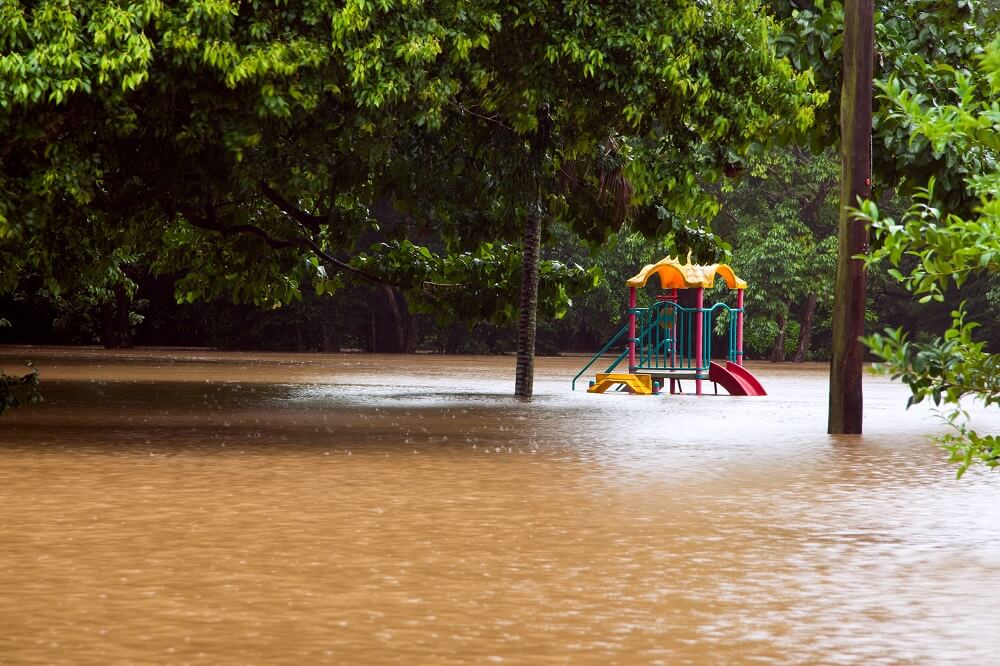Floodwater poses serious dangers

The lure of “playing” in floodwaters can be a deadly attraction, particularly for children.
Once the rain has gone, neighbourhood roadways, drains and parks can turn into rivers and lakes filled with floodwater.
Children, and even adults, are often quick to explore the new waterways, either unaware or disregarding the potential dangers.
Floodwater can hide all sorts of dangers, including slippery surfaces, uneven ground, strong currents, fences, rocks, long grass and weeds, tree branches, vehicles, sharp objects, chemicals, sewage and electrical current.
In some situations, the force of fast-flowing water can be multiplied many times.
Things like metal drains and grilles beneath the water can generate very strong suction and swift currents, and can quickly trap a person.
Even near the water’s edge, the currents, slope of the ground, or a slippery surface, can cause a person to lose their footing. People should stay at least 3m back from the waterline.
In urban areas, very large volumes of fast-flowing water can rise and fall in minutes, rapidly trapping, or sucking under, anyone who gets too close to drains, pipes or grilles.
These are not a place to play, or even to stand and watch, as they are slippery, have very strong pulling power, and it can be very hard to get out of them.
Even walking in floodwater can be dangerous. Water at ankle height can cause you to lose your footing and, once you have slipped and fallen, it may be very hard or impossible to get out.
What to do
If you become trapped
- Don’t enter the water if it can be avoided and stop others from entering it. Even fully equipped swift-water technicians will only enter the water as a last resort.
- Stay calm. Phone Triple Zero (000) or ask, or signal to, others to call for your rescue.
- Be patient – if you are in an isolated area, rescuers may take some time to reach you. If you are caught in a vehicle, try to stay there until help arrives, the water level goes down, or a safe escape is possible. • Listen to authorities who are trained professionals and follow their instructions.
If someone else is trapped
- Don’t enter swiftwater or floodwaters yourself – the best way to help is to report to emergency services and continue to monitor the person.
- Don’t tie a rope to yourself as you could be pulled in too; find a solid structure to use as an anchor.
- Try to use a tree branch, rope or similar item to reach the person if possible, but use extreme caution as fast-flowing water can force the trapped person further under the surface.
Related topics
Things to note
The information in this article has been prepared for general information purposes only and is not intended as legal advice or specific advice to any particular person. Any advice contained in the document is general advice, not intended as legal advice or professional advice and does not take into account any person’s particular circumstances. Before acting on anything based on this advice you should consider its appropriateness to you, having regard to your objectives and needs.
Insurance Products (excluding Travel Insurance) are issued by RACQ Insurance Limited ABN 50 009 704 152 (RACQI) and arranged by its agent, RACQ Distribution Services Pty Ltd (RDS) ABN 35 116 361 650, AFSL 567130 and RDS' authorised representatives (including RACQ Operations Pty Ltd ABN 80 009 663 414, AR No. 234978 (RACQO). Conditions, limits and exclusions apply. RDS and RACQO are in the RACQ group of companies. One of the companies in the RACQ group of companies has a minority shareholding in RACQI.
RDS and RACQO have not taken your personal objectives, circumstances or needs into account when preparing advice regarding insurance products and you will need to consider whether the advice is appropriate for you. Read the Product Disclosure Statement (PDS) and any applicable Supplementary PDS before making a purchase decision on this product. You can also access our Target Market Determinations on this website. RDS receives a commission from RACQI for the policies it arranges. RACQO receives fees paid for services it provides to RDS. Further details about remuneration are available on request prior to purchasing.
Banking and loan products issued by Members Banking Group Limited ABN 83 087 651 054 AFSL/Australian credit licence 241195 trading as RACQ Bank. Terms, conditions, fees, charges and lending policies apply. This is general advice only and may not be right for you. This information does not take your personal objectives, circumstances or needs into account. Read the disclosure documents for your selected product or service, including the Financial Services Guide and the Terms and Conditions, and consider if appropriate for you before deciding.
Except for RACQ Bank, any RACQ entity referred to on this page is not an authorised deposit-taking institution for the purposes of the Banking Act 1959 (Cth). That entity’s obligations do not represent deposits or other liabilities of RACQ Bank. RACQ Bank does not guarantee or otherwise provide assurance in respect of the obligations of that entity, unless noted otherwise.
RACQ Bank subscribes to the Customer Owned Banking Code of Practice which establishes higher standards than the law requires. The Code reflects modern consumer expectations and developments in approaches to issues such as consumer vulnerability, guarantors, and supporting customers through financial hardship. Please read our Customer Owned Banking Code of Practice page for more information.
RACQ Operations Pty Ltd (ABN 80 009 663 414 AR 000234978) and Members Travel Group Pty Ltd (ABN 45 144 538 803 AR 000432492) are acting as an Authorised Representative of the issuer of the insurance, Tokio Marine & Nichido Fire Insurance Co., Ltd. (ABN 80 000 438 291 AFSL 246 548). Any advice set out above is general in nature only, and does not take into account your objectives, financial situation or needs. Before purchasing any travel products, please consider the RACQ Travel Insurance Product Disclosure Statement (PDS) and the Target Market Determinations (TMDs) that apply to these products. Whilst the PDS outlines the Terms and Conditions of these products, the TMDs outline the intended class of customers that comprise the target market for these travel products. This will allow you to consider which products best suit your objectives, financial situation and needs and consider the products appropriateness to your personal circumstances. TMDs also outline matters involving the distribution and the review of these products. The PDS, Supplementary PDS and TMDs for each travel product can be found here.
